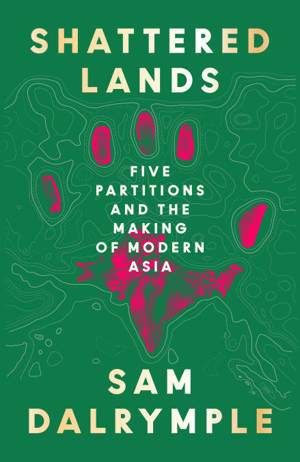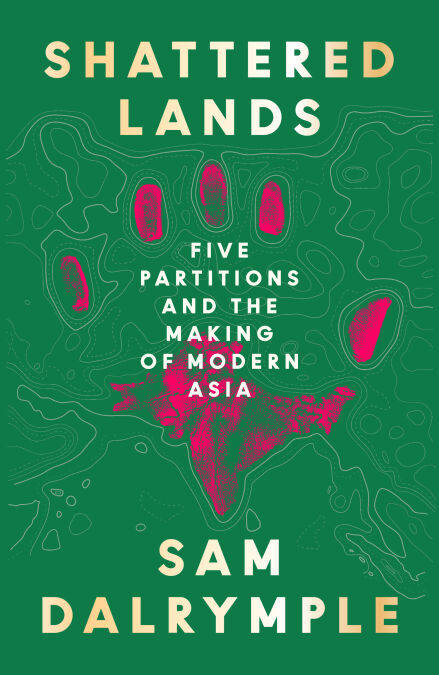
- Afhalen na 1 uur in een winkel met voorraad
- Gratis thuislevering in België vanaf € 30
- Ruim aanbod met 7 miljoen producten
- Afhalen na 1 uur in een winkel met voorraad
- Gratis thuislevering in België vanaf € 30
- Ruim aanbod met 7 miljoen producten
Zoeken
€ 27,20
+ 27 punten
Uitvoering
Omschrijving
** THE INTERNATIONAL BESTSELLER **
'A sparkling debut by an outstanding young historian' PETER FRANKOPAN
'Remarkable … The prose is vivid, the storytelling cinematic' GUARDIAN
‘This book is a revelation … both original and important' MISHAL HUSAIN
A history of modern South Asia told through five partitions that reshaped it.
As recently as 1928, a vast swathe of Asia – India, Pakistan, Bangladesh, Burma, Nepal, Bhutan, Yemen, Oman, the UAE, Qatar, Bahrain and Kuwait – were bound together under a single imperial banner, an entity known officially as the ‘Indian Empire’, or more simply as the Raj.
It was the British Empire’s crown jewel, a vast dominion stretching from the Red Sea to the jungles of Southeast Asia, home to a quarter of the world’s population and encompassing the largest Hindu, Muslim, Sikh and Zoroastrian communities on the planet. Its people used the Indian rupee, were issued passports stamped ‘Indian Empire’, and were guarded by armies garrisoned in forts from the Bab el-Mandeb to the Himalayas
And then, in the space of just fifty years, the Indian Empire shattered. Five partitions tore it apart, carving out new nations, redrawing maps, and leaving behind a legacy of war, exile and division.
Shattered Lands, for the first time, presents the whole story of how the Indian Empire was unmade. How a single, sprawling dominion became twelve modern nations. How maps were redrawn in boardrooms and on battlefields, by politicians in London and revolutionaries in Delhi, by kings in remote palaces and soldiers in trenches.
Its legacies include civil war in Burma and ongoing insurgencies in Kashmir, Baluchistan and Northeast India, and the Rohingya genocide. It is a history of ambition and betrayal, of forgotten wars and unlikely alliances, of borders carved with ink and fire. And, above all, it is the story of how the map of modern Asia was made.
Sam Dalrymple’s stunning history is based on deep archival research, previously untranslated private memoirs, and interviews in English, Hindi, Urdu, Bengali, Punjabi, Konyak, Arabic and Burmese. From portraits of the key political players to accounts of those swept up in these wars and mass migrations, Shattered Lands is vivid, compelling, thought-provoking history at its best.
‘A stunning achievement. Shattered Lands reframes the story of South Asia with rare empathy and elegance, breathing life into the legacies of the partitions that shape a quarter of our world today’ THANT MYINT-U
‘This richly researched, vividly written book tells the story of how a colossal and powerful Empire was broken up into many distinct nation-states…An impressive debut by a gifted and very energetic young writer’ RAMACHANDRA GUHA
'A sparkling debut by an outstanding young historian' PETER FRANKOPAN
'Remarkable … The prose is vivid, the storytelling cinematic' GUARDIAN
‘This book is a revelation … both original and important' MISHAL HUSAIN
A history of modern South Asia told through five partitions that reshaped it.
As recently as 1928, a vast swathe of Asia – India, Pakistan, Bangladesh, Burma, Nepal, Bhutan, Yemen, Oman, the UAE, Qatar, Bahrain and Kuwait – were bound together under a single imperial banner, an entity known officially as the ‘Indian Empire’, or more simply as the Raj.
It was the British Empire’s crown jewel, a vast dominion stretching from the Red Sea to the jungles of Southeast Asia, home to a quarter of the world’s population and encompassing the largest Hindu, Muslim, Sikh and Zoroastrian communities on the planet. Its people used the Indian rupee, were issued passports stamped ‘Indian Empire’, and were guarded by armies garrisoned in forts from the Bab el-Mandeb to the Himalayas
And then, in the space of just fifty years, the Indian Empire shattered. Five partitions tore it apart, carving out new nations, redrawing maps, and leaving behind a legacy of war, exile and division.
Shattered Lands, for the first time, presents the whole story of how the Indian Empire was unmade. How a single, sprawling dominion became twelve modern nations. How maps were redrawn in boardrooms and on battlefields, by politicians in London and revolutionaries in Delhi, by kings in remote palaces and soldiers in trenches.
Its legacies include civil war in Burma and ongoing insurgencies in Kashmir, Baluchistan and Northeast India, and the Rohingya genocide. It is a history of ambition and betrayal, of forgotten wars and unlikely alliances, of borders carved with ink and fire. And, above all, it is the story of how the map of modern Asia was made.
Sam Dalrymple’s stunning history is based on deep archival research, previously untranslated private memoirs, and interviews in English, Hindi, Urdu, Bengali, Punjabi, Konyak, Arabic and Burmese. From portraits of the key political players to accounts of those swept up in these wars and mass migrations, Shattered Lands is vivid, compelling, thought-provoking history at its best.
‘A stunning achievement. Shattered Lands reframes the story of South Asia with rare empathy and elegance, breathing life into the legacies of the partitions that shape a quarter of our world today’ THANT MYINT-U
‘This richly researched, vividly written book tells the story of how a colossal and powerful Empire was broken up into many distinct nation-states…An impressive debut by a gifted and very energetic young writer’ RAMACHANDRA GUHA
Specificaties
Betrokkenen
- Auteur(s):
- Uitgeverij:
Inhoud
- Aantal bladzijden:
- 528
- Taal:
- Engels
Eigenschappen
- Productcode (EAN):
- 9780008466831
- Verschijningsdatum:
- 18/06/2025
- Uitvoering:
- E-book
- Beveiligd met:
- Adobe DRM
- Formaat:
- ePub

Alleen bij Standaard Boekhandel
+ 27 punten op je klantenkaart van Standaard Boekhandel
Beoordelingen
We publiceren alleen reviews die voldoen aan de voorwaarden voor reviews. Bekijk onze voorwaarden voor reviews.











